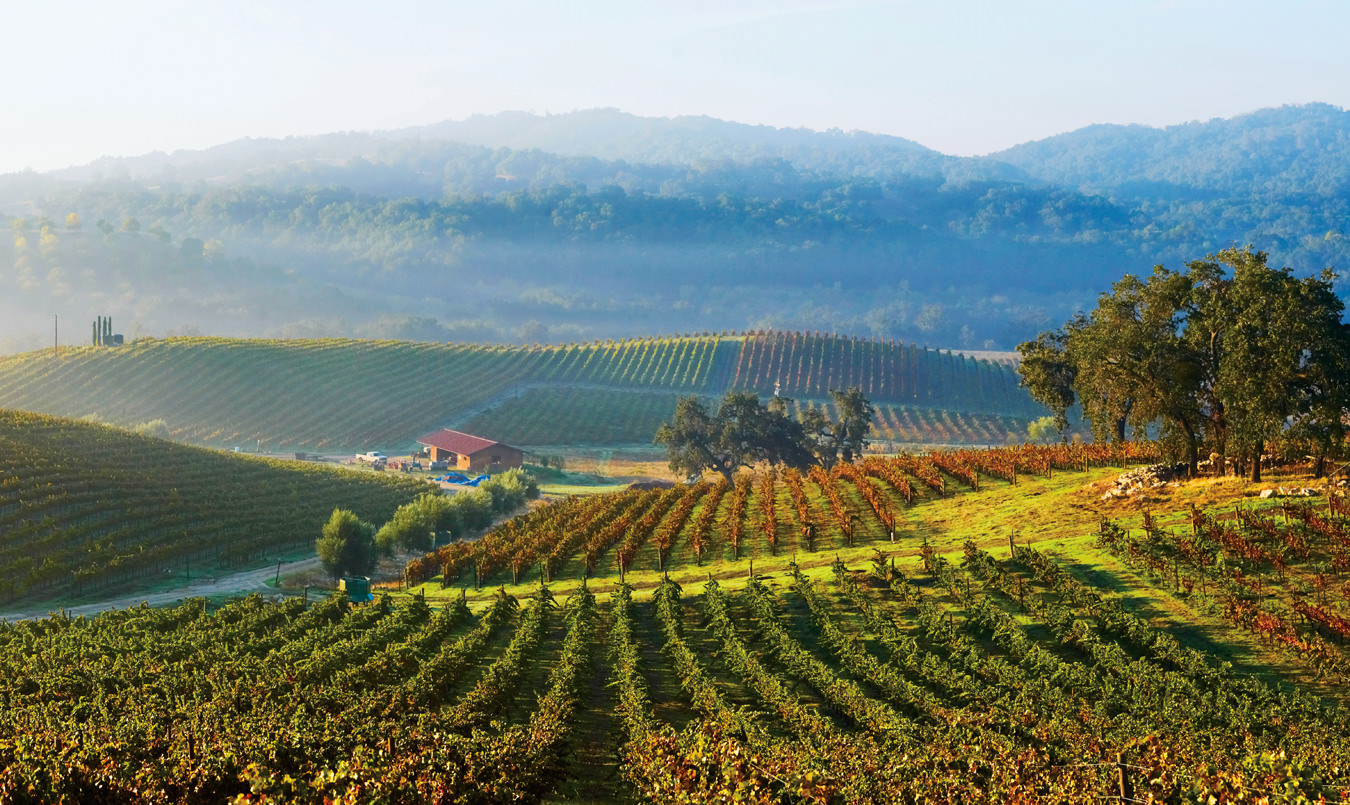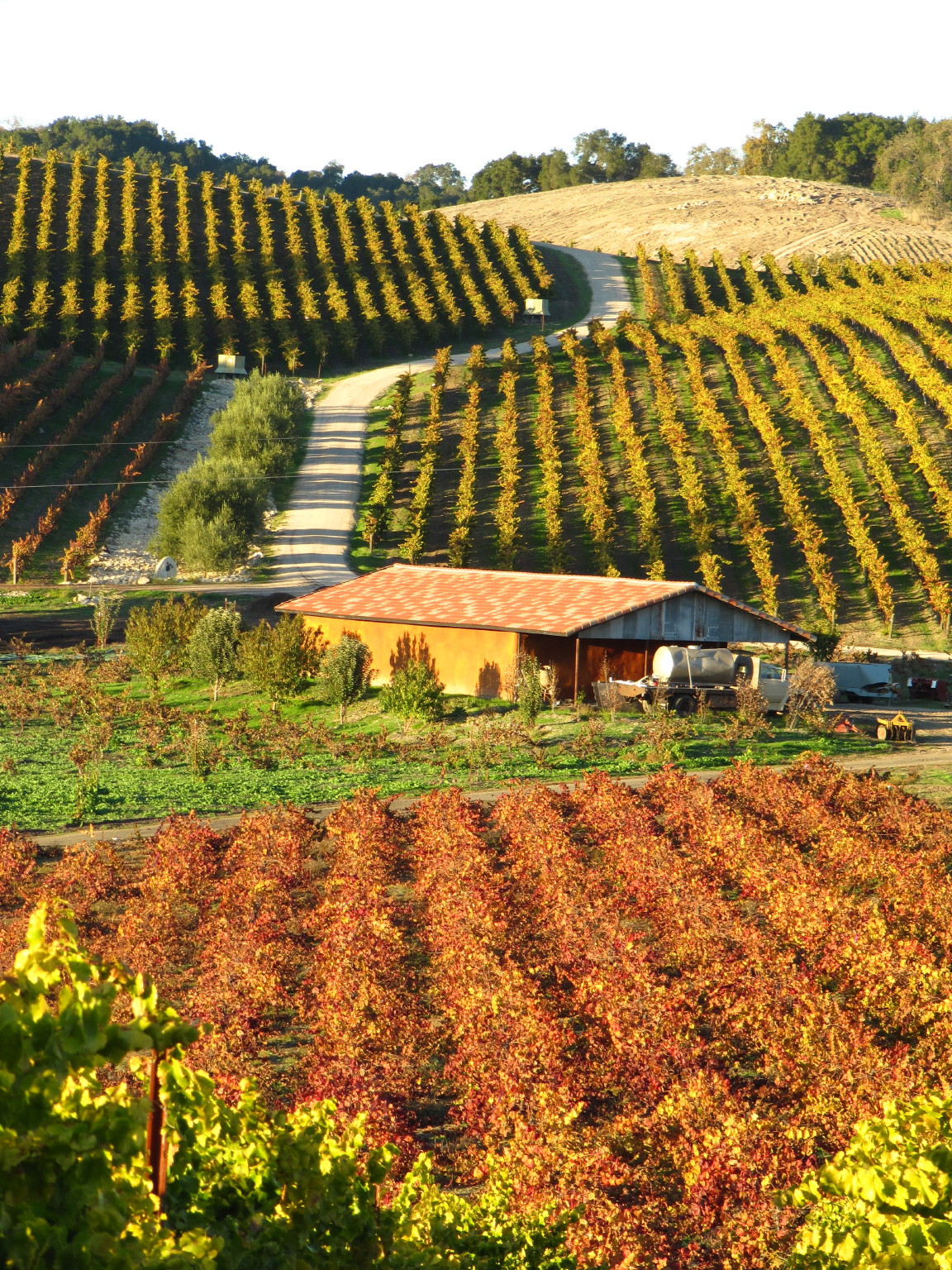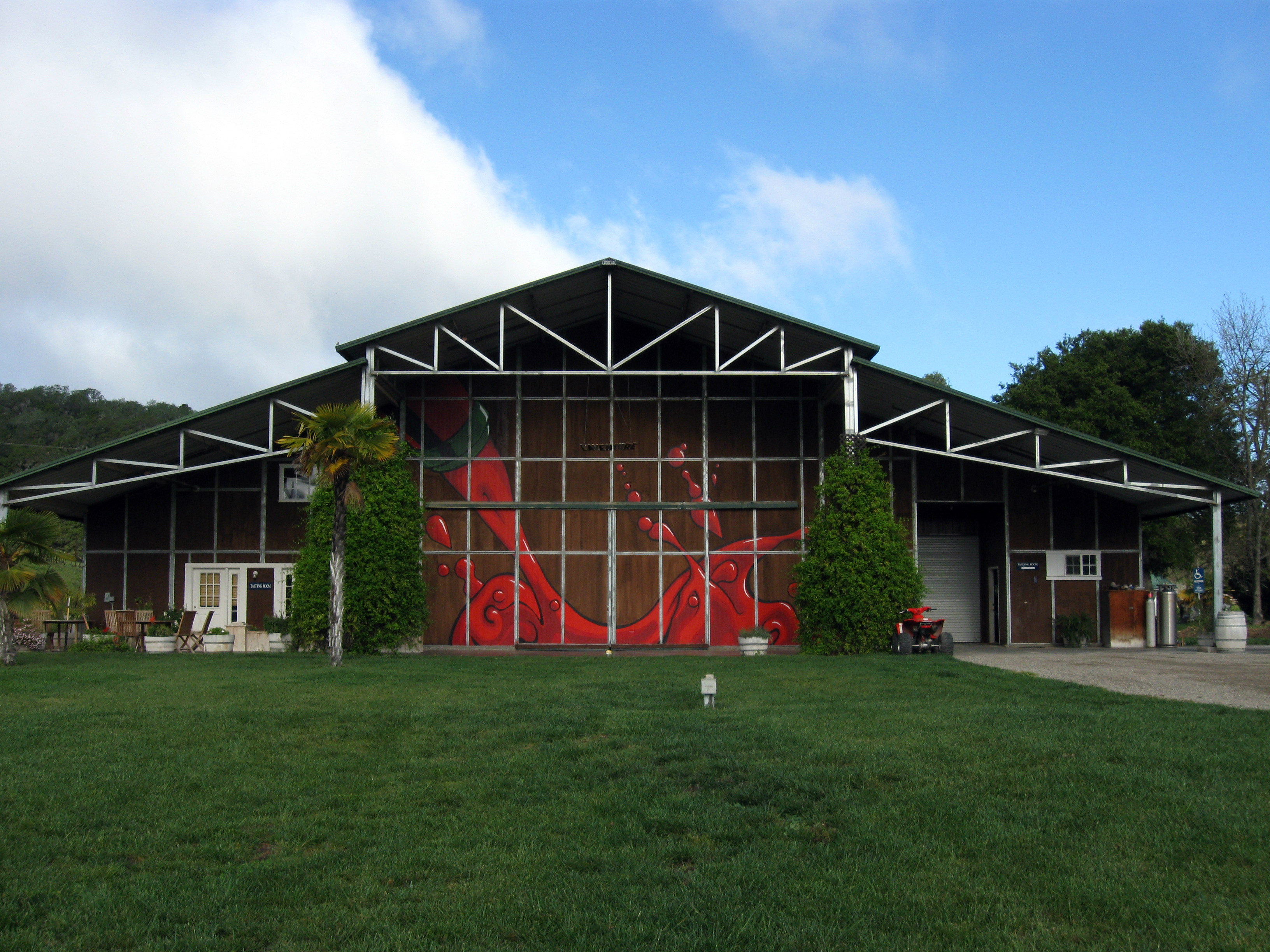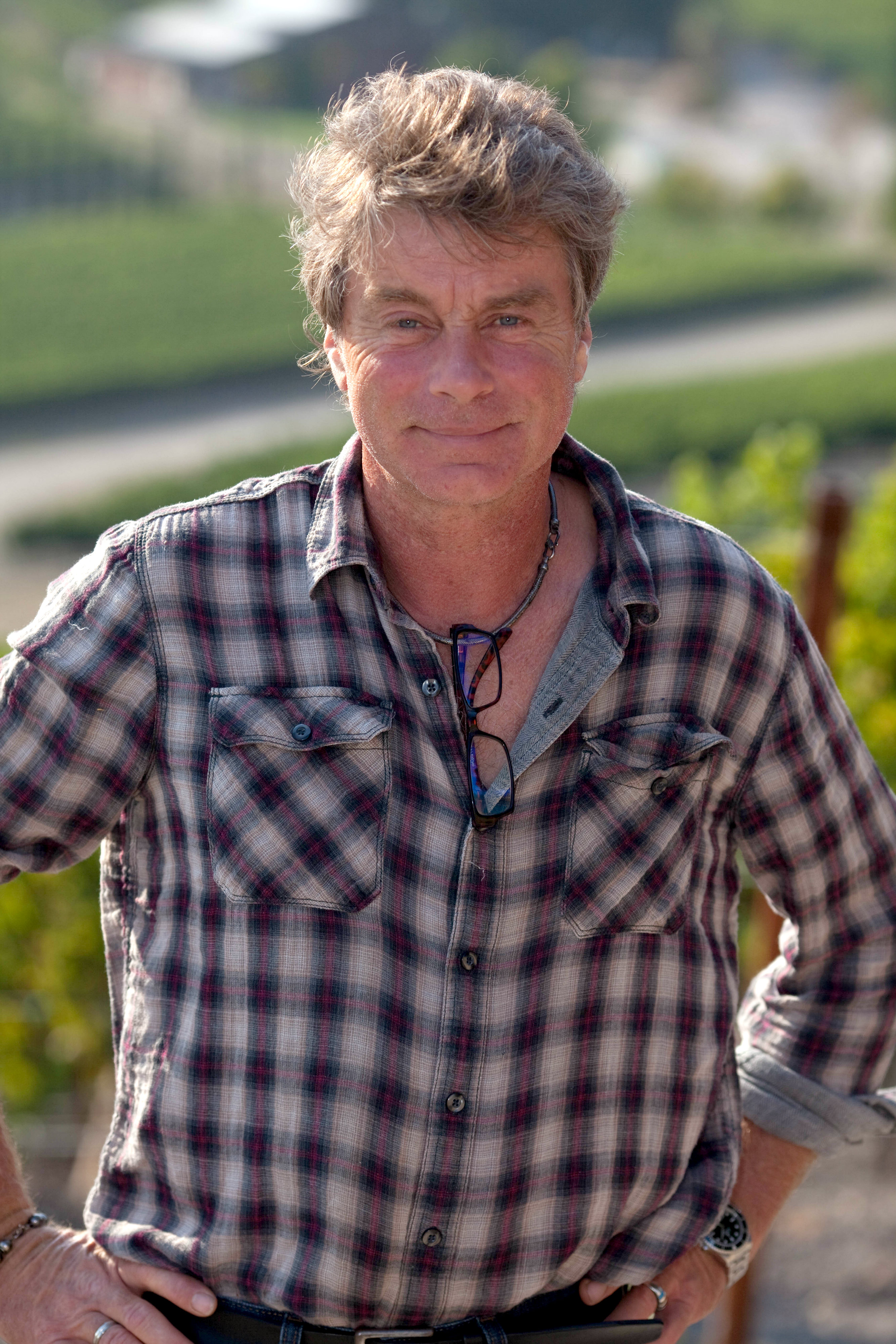-

California’s Tablas Creek Vineyard is a collaboration between the Perrin family, owners of France’s Château de Beaucastel, and the Haas family. Photo provided by Tablas Creek Vineyard.
-

The fields in autumn at Tablas Creek Vineyard. Photo provided by Tablas Creek Vineyard.
-

L’Aventure Winery on the west side of Paso Robles.
-

Stephan Asseo of L’Aventure Winery began planting vines in 1998.
-

The Eberle Winery vineyard. Photo© Chris Leschinsky, 2011.
-

The Eberle Winery caves.
The Mediterranean Varieties of Paso Robles
Rhone on the range.
Sometimes it’s the vegetation, not the grape vines, that tells you which wine region you’re in. Grape vines can look the same everywhere, but cypress trees identify Tuscany while the garrigue (low-lying bush made up of wild herbs) tells you you’re in Languedoc. In California’s Paso Robles wine region, halfway between Los Angeles and San Francisco, the oak trees lining the roads and punctuating the vineyards identify the place—hardly surprising as Paso Robles translates as Pass of the Oaks.
Paso Robles (known locally as “Paso”) first attracted the attention of Europeans for its hot springs, and later became famous for almond orchards and cattle ranches. The ranches are still important, but a new crop—grapes for wine—is now at the cutting edge. Paso Robles is one of California’s smaller wine regions. Its total 32,000 acres of vines are the size of a few large cattle ranches but it quickly developed a reputation for quality and especially for wines made from the grape varieties that grow around the Mediterranean. Paso Robles is at the heart of the Rhone Rangers, the organization formed in the late 1990s to promote the grape varieties grown in France’s Rhone valley.
It’s not that Mediterranean varieties (mainly associated with southern France, Italy, and Spain) are dominant in Paso Robles. There are 40 to 50 varieties in all, but 40 per cent are cabernet sauvignon, California’s most common variety for red wine, and they and the Bordeaux varieties account for more than half the vines. But although the Mediterranean varieties are a minority, they punch well above their weight, making distinctive varietal wines and compelling blends with one another and with cabernet sauvignon and merlot.
One of the key figures of the region is Gary Eberle, locally known as the “Godfather” because of his long history of winemaking in the Paso Robles region. He was the first winemaker in the U.S. to produce a 100 per cent syrah varietal wine in 1975 and co-founded the Paso Robles American Viticultural Area in 1983. Eberle’s vineyards now include his flagship cabernet sauvignon, as well as syrah, viognier, sangiovese, barbera, and zinfandel. (Zinfandel is the same variety as primitivo from Puglia, in southern Italy, and both relate to a variety from Croatia.)
Eberle quips: “A wine’s first responsibility is to be red,” but some of his fine wines are white—the 2013 Côtes-du-Rôbles, a blend of roussanne, grenache blanc, and viognier, shows a little viscosity but bright acidity and lovely fruit. The reds include a 2012 Barbera from grapes left on the vine longer to produce luscious fruit that deliver juicy acidity, and a 2013 Syrah from the Steinbeck vineyard planted in 1980 that is a dry wine with concentrated fruit and rich tannins. Many of these wines are keepers. The 2000 Syrah holds its freshness exceptionally well.
At Tablas Creek Vineyard the inspiration was not generic Mediterranean, but specifically Châteauneuf-du-Pape: the winery is a partnership of the Perrin family, which owns the iconic Château de Beaucastel estate there, and long-time wine importer Robert Haas. They bought land in Paso Robles in 1989, imported vine cuttings from Château de Beaucastel, and finally planted them in 1994 when they were released from quarantine. The Rhone–Paso Robles partnership greets visitors as they arrive at the winery: one directional sign points east and reads “Domaine de Beaucastel: 9009 km” while another points to the tasting-room door and reads “Tablas Creek Vineyard: 9 yards”.
As you would expect, these wines are solidly Rhone in composition. Some are single varietal wines, like the lovely 2013 Tablas Creek Vineyard Roussanne, which delivers quite densely concentrated fruit combined with lively acidity, and a 2014 Grenache Blanc in a similar style. Among the stand-out reds are the 2011 Esprit de Tablas, a big and tannic yet elegant blend of mourvèdre, syrah, grenache, and counoise, and a 2013 Grenache that’s fresh and clean with both depth and breadth. Jason Haas, son of the founder, says: “There are too many wines where you don’t finish the first glass, let alone the complete bottle.” At Tablas Creek, grapes are picked earlier to get good acidity and to keep the alcohol down (they calculate it reduces alcohol by about 1 per cent) and the result is wines with sheer drinkability.
California’s Paso Robles is at the heart of the Rhone Rangers, an organization promoting the grape varieties grown in France’s Rhone valley.
A larger winery is Hope Family Wines, which makes well-known brands such as Treana and Liberty School. Among the Mediterranean varietals are a 2012 Austin Hope Roussanne, which shows ripe fruit right through the palate and excellent balance, and a 2012 Austin Hope Grenache, which has extended time on the grape skins for more silky tannins. It carries its high alcohol (15 per cent) easily. Another Hope red is Troublemaker Red Blend, which originated, says assistant winemaker Samantha Taylor, as an accidental blend of petite sirah and zinfandel; it is now one of the winery’s most successful wines in terms of sales.
Paso Robles is varied in its landscapes and climate. J. Lohr Vineyards & Wines has exploited the range of conditions by planting 22 vineyards in different districts for a total of 2,112 acres. J. Lohr Estates Seven Oaks Cabernet Sauvignon, its name derived from the seven oak trees on the property, is one of the best-known labels. J. Lohr grows 12 varieties in Paso Robles—mostly cabernet sauvignon, merlot, and syrah, but also a good range of Mediterranean varieties—and their “Gesture” line is made mostly of varieties from the Rhone valley.
The 2014 J. Lohr Gesture Viognier (with a little roussanne and grenache blanc) delivers lovely aromatics, followed by sweet fruit and a fresh texture, while in the 2014 J. Lohr Gesture RVG roussanne and grenache blanc star and viognier plays a minor role. RVG is a bigger white with impressive texture, and is said to age well. Most of J. Lohr’s reds are cabernet- and merlot-dominant, but there are also Mediterranean reds, such as the 2013 J. Lohr South Ridge Syrah, a juicy and refreshing syrah that has minor contributions from grenache and mourvèdre. Growing all those other reds doesn’t prevent Jerry Lohr, the winery’s founder, from being part of the local chapter of the Rhone Rangers.
Paso Robles is very friendly to wine tourists and many wineries have restaurants, but some have gone further. Vina Robles Winery is not only a full-fledged wine-producing facility, but has also built a massive amphitheatre for concerts. Needless to say, you can enjoy Vina Robles wines as you listen to the likes of Ringo Starr, Steely Dan, or Marilyn Manson (some of 2015’s open-air performances). Among the wines you can drink are the 2014 White 4, a delicious, crisp white blend of viognier, vermentino, verdello, and sauvignon blanc, and a 2012 Petite Sirah, a solid red with deeply textured fruit and bright, juicy acidity.
Some of Paso Robles wineries are substantial, producing hundreds of thousands of cases of wine a year. Then there’s L’Aventure Winery, the adventure of Stephan Asseo, a winemaker from France. Drawn to the climate and soils of the west side of Paso Robles, he started planting vines in 1998 and now makes a small range of wines at the luxury end of the spectrum. The 2013 Côte à Côte is a pure southern French blend of mourvèdre, grenache, and syrah that’s stylish and sleek, with structure to spare. The 2013 Estate Cuvée, mostly syrah and cabernet sauvignon with some petit verdot, is full-bodied, concentrated, layered, and juicy. Both capture the style of L’Aventure wines, which embody power, structure, and style.
In the next few years we’re going to see a lot of wines made from Mediterranean varieties but not from Mediterranean wine regions. Climate warming is forcing wine producers in already warm regions to look for varieties that will perform well in a little more heat and with less water. Mediterranean varieties are already established in Australia and they’re popping up in other parts of California and other states. But Paso Robles has a head start and has worked out the kinks of blending these varieties with one another and with varieties that come from other places.
Winemaking is always a work in progress, but sometimes a region reaches a point at which it has achieved a balance of achievement and innovation, a point at which the region can take a breather without being complacent. With its Mediterranean-inspired wines, Paso Robles is there.




